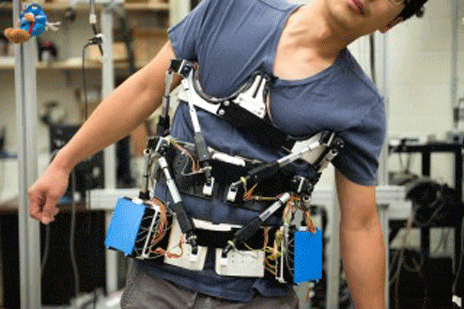
Pictured here is a prototype of the wearable dynamic spinal brace developed at Columbia University School of Engineering and Applied Science. Sensors record the force and motion data, and transmit the information to a computer for monitoring and treatment. (Photo courtesy of Jane Nisselson at Columbia Engineering)
A Columbia University School of Engineering and Applied Science professor and his research team recently won a $1 million grant from the National Science Foundation’s National Robotics Initiative to develop dynamic, and less rigid, scoliosis braces for kids.
A media release from the university notes that typical spinal scoliosis braces are made from rigid plastic that fits around the child’s trunk and hips, and apply counter-pressure on the spine’s abnormal curve.
However, according to the release, these braces limit movement of the child’s upper body. Also, as the child matures, the external forces that are required to correct the scoliosis change along the length of the curve and over the course of treatment.
With that in mind, Sunil Agrawal, PhD, a professor of mechanical engineering and of rehabilitation and regenerative medicine at Columbia University School of Engineering and Applied Science, New York City, and his team are developing a scoliosis brace that would be flexible enough to enable scoliosis patients to move while still applying corrective forces to the spinal curvature, the release explains.
“Every year, 30,000 children use a rigid brace to treat scoliosis, while 38,000 patients undergo spinal fusion surgery, so this award will make a big difference,” Agrawal says, in the release.
“If we can design a flexible brace that modulates the corrective forces on the spine in desired directions while still allowing the users to perform typical everyday activities, we will bring revolutionary change to the field,” he adds.
He and his team—David P. Roye, Jr, MD, St Giles Foundation Professor of Pediatric Orthopedic Surgery at the Columbia University Medical Center, and Charles Kim, PhD, professor of mechanical engineering at Bucknell University—have also developed prototypes of two different wearable spine braces.
The first consists of rings that fit onto the torso that are dynamically actuated by servomotors placed on adjacent rings to control the force or position applied on the human body. Onboard sensors record the force and motion data and transmit the information to a host computer for monitoring and adjusting the treatment, per the release.
the second is a fully passive brace made from compliant components that able to adjust stiffness in specific directions, the release notes.
“While we are the first group to propose parallel-actuated spine braces and compliant braces, these are just in initial phases,” Agrawal explains in the release.
“What we will do, thanks to the NSF award, is to design hybrid semi-active spine braces that combine the merits of the two. These will be less power hungry and can be worn over a longer duration of time,” he continues.
Per the release, the team plans to test all three of their prototype scoliosis braces on children at Columbia University Medical Center.
[Source(s): Columbia University School of Medicine and Applied Science, Newswise]





